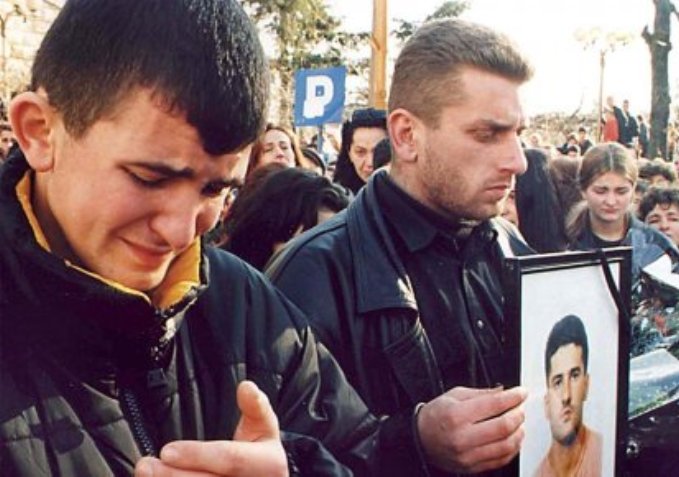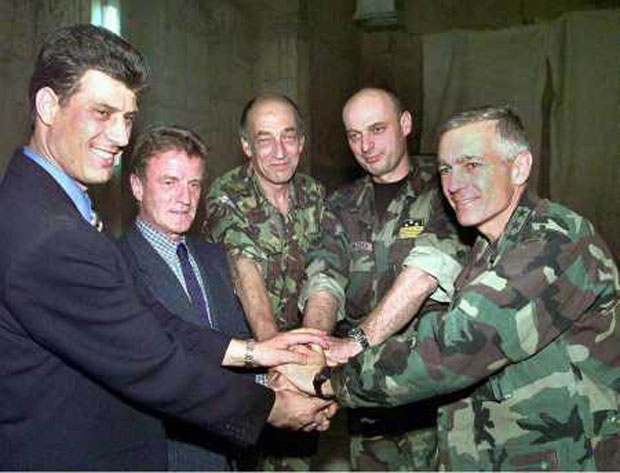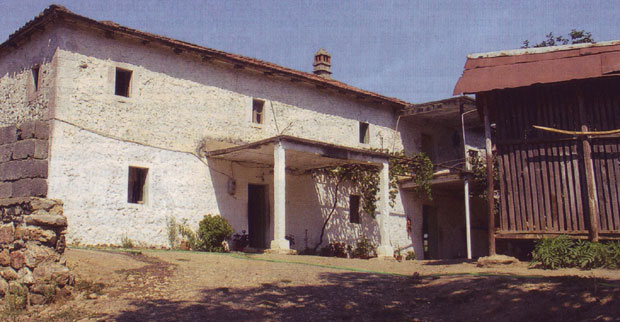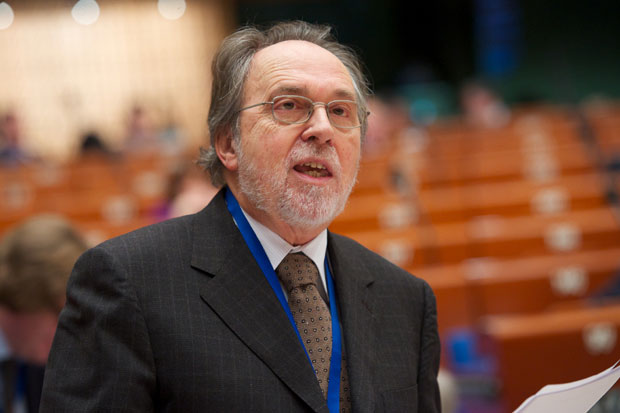Period:
Yugoslav Wars
Region:
Albania
The Albanian Camp Kukeš in 1999
The Kukeš camp (Alb. Kukës) is an Albanian concentration camp that existed in the late 1990s in the northern part of the Republic of Albania during the NATO aggression on Serbia and Montenegro.
This is one of a dozen of casemates of death known to have existed on the territory of another country (Deva, Tropoje, Burrel, Chakan, Durres…), in which Serbs and non-Albanians were brought, as well as Albanians loyal to the state institutions of the FR Yugoslavia.
The Kukeš camp, although stationed on the territory of the Republic of Albania, was under the jurisdiction of the officers of Albanian paramilitary, the so-called KLA, Kosovo Occupation Army, and not the army of the Republic of Albania.
Officers of the North Atlantic Alliance and the Albanian army knew about the existence of the death camp, as well as that the prisoners were taken from there to other camps, such as Burrel, close to Tirana, but nothing was done to close it.
According to the estimates of the members of security services, at least one hundred people were imprisoned in this concentration camp, almost all of them from the area of the Autonomous Province of Kosovo and Metohija.
The Hague Tribunal has convicted only one member of the Albanian (para)military formations from the Balkans area of war crimes and crimes against humanity, for the Lapušnik camp. Also, only one person was sentenced to 15 years in prison for the crimes in the Kukeš camp.
BACKGROUND
The Federal Republic of Yugoslavia (1992-2003) was the third Yugoslavian state formed as a result of the disintegration of the Federal State of Yugoslavia, when Serbian and Montenegrian delegates proclaimed the constitution in Žabljak in April 1992.
At the same time, in the territory of the Federal State of Croatia, Croatian forces continued with their aggression against Krajina Serbs, who had formed their Republic of Serbian Krajina.
In Bosnia and Herzegovina, a bloody war was already in progress between Serbs, Muslims, and Croats. These conflicts ended in the Autumn of 1995 when the Dayton Peace Agreement was signed in the state of Ohio.
Soon, American military campaign became centered around assisting Albanian separatists from Kosovo and Metohija, providing them with weapons and logistics, and creating terrorist camps in Albania. This is when the Albanian terrorist group (KLA) was formed, whose members were illegally transported into the territory of Yugoslavia aimed at looting, trafficking, destabilization, and provocation of conflicts with the Police and Army of Yugoslavia.

Funeral of Serbian victims in Peć- December 1998.
In the Spring of 1998, conflicts between Albanian terrorists and members of Yugoslavian police intensified, resulting in the war, with a lot of casualties on both sides. Albanian terrorists were directly supported by the Western countries.
This support also included threats by the NATO that it would intervene in the conflict if Belgrade kept refusing to decrease the number of soldiers and policemen in Kosovo and Metohija.
In the Autumn of 1998, NATO began to bring its soldiers and technique to the Vardar Macedonia and Albania, while the “Milošević-Hoolbruk” agreement helped to prevent aggression against Serbia on 13 October 1998.
Situation in Kukeš town
Kukeš (Kukes) is a town in the north of Albania located in the valley of the Veliki Drim river on the road Prizren (40km) - Skadar (140km).
The old part of the town was flooded in the 70s of the 20th century when the regime of Enver Hoxha decided to make a dam, Fierza reservoir, and power plant. This is when the new town of Kukeš was founded, which had 13,000 residents in the year 1998 when the camp operated.
Traffic connection with other cities in Albania is poor resulting in great poverty of its people, who, thus, turn to criminal activities and the black market.
ESTABLISHMENT OF THE CAMP
At the beginning of October 1998 in Kosovo and Metohija, after armed actions of the police forces of the Republic of Serbia, the units of the Albanian terrorist Kosovo Occupation Army were decimated and destroyed. This led to the North Atlantic Alliance interfering in internal affairs of the FR Yugoslavia and helping Albanian separatists, who had a common goal to separate Kosovo and Metohija from Serbia and annex it to the motherland, which would realize their centuries-old dream of “Great Albania”.
The bombing of Serbia and Montenegro was avoided at the moment by the “Milošević-Hoolbroke” agreement, so that 1,300 OSCE verifiers (foreign spies, actually), led by William Walker were sent to Kosmet. Their goal was to record the Serbian security forces’ position and place locators to guide the missiles to the targets. Also, large-scale smuggling of weapons, ammunition, equipment, etc. took place over the mountain range of Prokletije with inaccessible terrain, which led to the resumption of their terrorist activities after the reorganization under the command of Hashim Thaci and Ramush Haradinaj.
Walker faked “The Račak Case” that the police forces of the Serbian Ministry of the Interior allegedly killed Albanian civilians on 15 January 1999, and not terrorists of the so-called KLA, which Yugoslav general Božidar Delić proved at the Hague Tribunal years later. However, the NATO pact was given an excuse to carry out the aggression on FR Yugoslavia, which was launched on 24 March 1999 and lasted for 78 days.
Immediately after the beginning of the genocidal campaign “The Merciful Angel”, the officers of the so-called KLA came to an abandoned metal industry factory in the town of Kukeš, with production halls and an administrative building where the yard was fenced with wire.
As NATO planes started dropping bombs on military and civilian targets, Albanian refugees set off along the Beli Drim valley towards Albania, and Kukeš was the first town only 19 km away from the then Yugoslav-Albanian border.

Hashim Thaci, Wesley Clark agreed on a “deal”
or cooperation against Serbs
CAMP OPERATION
Due to its important geostrategic position, Kukeš was chosen as the Military Police base and the camp of the so-called KLA. It was a training center for war and terrorist actions.
Members of the so-called KLA intercepted people from the column of refugees, robbed and mistreated them. A large number of them ended up in the Kukeš or other camps. There, tortures, beatings, and killing of Albanians and Roma continued. There were also rapes of women who were forcibly brought there. In addition, kidnapped Serbs from the southern parts of Kosovo and Metohija, i.e. Prizren and the surrounding places were also brought there. They were all victims of a joint criminal enterprise.
The commander of the Kukeš camp was Sabit Geci, the head of the Albanian intelligence service in Kosovo and Metohija (SHIK). He was also in charge of transporting prisoners to the town of Burrel, where there was a special camp “The Yellow House” in which human organ trafficking was developed, with organs sold on the European black market. His deputy was Bislim Zirapi, also an officer of the so-called KLA.
A lot of prisoners were Kosmet Albanians aged 20-30 who were taken out of the column under suspicion that they were spies and collaborators of the Yugoslav intelligence service.
Food and water supply in the camp was very scarce according to the survivors’ testimonies. Bathing did not exist at all, nor did medical care. The use of toilets was also limited.
There were several Serbs among the prisoners. One of them was a police officer in the Djakovica MUP. He was also taken away in a yellow Mercedes and never seen again. Also, another one had an offense because he had a permit for carrying arms issued by the Yugoslav authorities.
Among the guards were also KLA members who had come back from Kosmet (Kosovo and Metohija) where their units had suffered heavy losses. They were particularly sadistic towards the prisoners.
NATO officers never came to the camp, although they had to pass there often, especially during the land invasion on Serbia at the end of May 1999 in the area of Beli Drim, known under the codename “Arrow 2”.

Infamous Yellow House near the town of Burrel in Albania
The guards used to remove the killed detainees in three ways. The first was to throw them into the river Drim, the second to bury them at an unknown location of the surrounding mountains, and the third to bury them in the local cemetery in Kukeš, where there are some records.
TESTIMONIES
One of the protected witnesses in the court told this about the abuse in the Kukeš camp:
- “I watched them beat people, stab them with knives, hit with bats… I watched them leave people without food for five or six days. I watched them put coffins into graves. I watched them kill.
They were all civilians who hadn’t taken part in the fighting, mostly Albanians and Roma who were accused of cooperating with Serbian authorities…”
The second protected witness who had spent several weeks in the Kukeš camp told this before the EULEX investigating authorities:
- “Outside the camp, I could clearly hear the eerie screams from the torture of the prisoners who were taken outside the camp complex. It was clear that Serbian was their mother tongue.
An Albanian died when the guards shot his legs and then left him on the floor to bleed to death.
The prisoners were beaten to death, many of them were killed by firearms in the camp itself. After the murder, they were put in a yellow Mercedes and then taken away in an unknown direction.
The third protected witness said the following about his imprisonment in the Kukeš camp:
- “One of the prisoners was a Kosmet Albanian. He shouted to the guards through the window bars that he had six brothers who were going to avenge him if they killed him… I saw with my own eyes that at least 18 people were killed at the camp.
The prisoners were treated brutally. I don’t think that all those people collaborated with Serbs. But even if they did, they certainly didn’t deserve to be punished in that way. No one has the right to torture other people like that. You don’t treat human beings this way…”
The fourth protected witness says the following about the camps in Albania:
- “I was first brought to the Kukeš camp where I spent several days, and then we were moved to the town of Burrel where there were also a terrorist camp and a concentration camp. We saw horrible things there. They killed people and then threw them into lime pits. The Burrel camp was far more terrible than the Kukeš camp. It was a real hell. You could see that by tortured people. Few of them survived…”
CLOSING OF THE CAMP
After the NATO aggression ended in mid-June 1999 when the Military-Technical Agreement was signed in Kumanovo, the Yugoslav Army and Serbian Police, as well as state institutions, withdrew from the territory of Kosovo and Metohija, and KFOR and UNMIK took over the southern Serbian province.
Since the Kukeš camp was no longer needed, it was closed and the remaining prisoners were transferred to Burrel.
YEARS LATER
Upon their return to Kosmet, Albanian extremists started to attack Serbs, kill, rob, rape, destroy everything that has to do with Serbs and Orthodoxy; everything was under attack.
At the beginning of October 2000, there was a change in political power in Serbia, when Zoran Đinđić (2000-2003), and later Vojislav Koštunica (2004-2008), formed the government. They made a radical turn in Serbia’s foreign policy, i.e. it was the policy of Euro-Atlantic integrations.

Zoran Djindjic, Vojislav Kostunica and Mladjan Dinkic
Under these conditions, more than 2100 criminals, members of the so-called KLA who were interned in Yugoslav state prisons were released. They had been sentenced to many years in prison (10-25) for serious criminal offenses: murders, tortures, rapes, robbery, destruction of property, destruction of Orthodox shrines, etc. They did not ask the Albanian party to release Serbian civilians from Albanian camps.
The fate of more than 1,647 Serbs from Kosovo and Metohija is still unknown.
TRIALS AND INDICTMENTS
Up to now, only one person has been indicted for the crimes committed at the Kukeš camp, and that is Sabit Geci, a very close associate of Hashim Thaci, the officer of the Drenica group of the so-called KLA, also known by the nickname “The Big Boss”. An investigation against him was launched in 2002, but it was not until 2011 that he was sentenced before the Priština Court where the EULEX has jurisdiction to 15 years in prison for torturing, abusing, and killing prisoners in the Kukeš and Chakan camps in northern Albania, but the verdict referred to Albanian victims, and not Serbian ones.
At the end of January 2020, Sabit Geci was interrogated in the EULEX office in Priština, at the invitation of the Special Court in the Hague, regarding the crimes he committed in 1998-1999 in Kosovo and Metohija and camps of the Republic of Albania.
During his five-year tenure in Kosovo and Metohija, Hose Pablo Barajbar, Head of the Office for Missing Persons and Judicial Expertise at the UNMIK Mission, claimed that even today there are living witnesses who could testify about their imprisonment in Albanian camps, including Kukeš, but they fear for their personal safety and their families.
During 2005-2010, Swiss lawyer and senator Dick Marty worked to unravel cases of kidnapped Serbs and non-Albanians, their transfer to the Republic of Albania, organ harvesting in the Yellow House… and he presented this report to the Council of Europe on 14 December 2010. This didn’t have the desired effect because the main culprits and organizers are protected by the Europan Union.

Dick Marty, lawyer of Switzerland
Later when he asked the Hague Tribunal for information on the evidence he had collected with his associates regarding the Yellow House, he was told that the evidence had been removed to clear the area, because the evidence “was of no use”. Marty confirmed that the Hague Tribunal investigators in Kosmet and Albania did their job extremely unprofessionally and amateurishly.
Tags:
Please, vote for this article:
Visited: 1773 point
Number of votes: 5
|